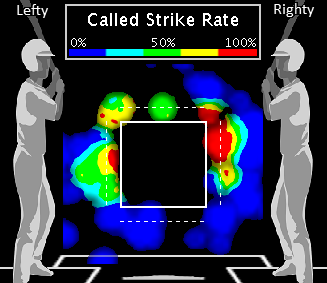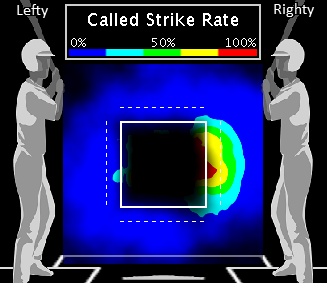Other Side of the Coin: Rodney's Fortune on Called Strikes
 Sam Waters |
Sam Waters |  Friday, May 18, 2012 at 2:18AM
Friday, May 18, 2012 at 2:18AM
Fernando Rodney has been one of this season’s most pleasant surprises in relief, as Mr. Golebiewski noted yesterday. An average to below-average pitcher for most of his career (4.13 ERA, 4.07 FIP), Rodney suddenly sports a 0.48 ERA with 9.16 K/9 and 1.45 BB/9 through the first quarter of the 2012 season. The strikeouts are not too far out of line with his career profile, but the lack of walks are shocking from a guy who has never flashed even average control. His career BB/9 is 4.73, so the main question here is the sustainability of Rodney’s newfound command.
One good indicator of truly improved command would be an increase in number of pitches thrown in the strike zone. From 2008 to 2011, Rodney’s respective Zone Percentages (Pitches in Strike Zone/Pitches) were 48.2%, 51.2%, 49.7%, 46.2%. This year he finds himself at 48.6%, which doesn’t seem at all out of line with his previous rates. So if Rodney is not getting the ball in the zone more often, what is he doing differently?
Golebiewski does a great job of covering one of the main changes- batters are chasing more of Rodney’s pitches out of the zone, turning would-be balls into strikes. But Rodney has seen another key change in his profile that is playing an important role in his success. He has recorded a called strike rate of 17.2% on pitches taken out of the zone. Assuming that the In Depth Baseball platform is both accurate and unbiased in its pitch location tendencies, 17.2% of these pitches are “missed calls”- called strikes that should have been balls. Out of 305 pitchers with at least 100 pitches outside of the zone, Rodney stands at tenth in called strike rate (Brett Lawrie got some experience with Rodney’s luck on called strikes this week, and was not too pleased about it.) For Rodney to sustain such a low walk rate, he is going to have to continue to get the same amount of leeway from umpires that he has been receiving up to this point.
Many pitchers do consistently get more respect than others from umpires when it comes to the fringe of the strike zone. Mariano Rivera, for example, has always gotten some breathing room from umps, posting above-average called strike rates on pitches outside of the zone every year since 2008 (when In Depth’s data starts). A player’s pitch selection can also affect this rate, as certain types of pitches are called incorrectly more often. The problem is that Fernando Rodney has never demonstrated an affinity for getting generous calls on pitches outside of the strike zone.
Pitches Outside of the Strike Zone
|
|
G |
P |
PA |
ClStk% |
|
Totals |
237 |
2146 |
432 |
7.4% |
|
2012 Season |
18 |
133 |
27 |
17.2% |
|
2011 Season |
39 |
332 |
67 |
4.2% |
|
2010 Season |
72 |
643 |
131 |
6.1% |
|
2009 Season |
72 |
650 |
127 |
7.5% |
|
2008 Season |
36 |
388 |
80 |
9.2% |
His career called strike rate of 7.4% outside the zone is significantly lower than his 2012 rate of 17.4%. The heat maps below do a good job of demonstrating the difference between the more familiar Rodney of old and the Rodney of 2012 in their luck with strike calls. The first map shows the calls Rodney has gotten this year in a sample of just 133 pitches, while the second map shows Rodney’s calls received over the previous four seasons with a sample of about 2,000 pitches:
2012, Outside of Strike Zone

2008-2011, Outside of Strike Zone:

If Rodney regresses from the results of the first map to those of the second, or even to a middle ground around the league average of 10%, he should experience a precipitous decline in strikes and a corresponding rise in walks. Just remember that this comes with a caveat- if Rodney really has changed his approach and is, for example, getting a lot more movement on his pitches, it is possible that umpires will continue to have a difficult time calling his pitches correctly. One adjustment that stands out is Rodney’s decision totransfer about 7% of his arsenal from change-ups to fastballs. A look at pitchers over the last five years shows that fastballs outside the zone are called strikes at an above average rate (about 12%), while change-ups outside the zone are called strikes at a below average rate (about 8%). While this might explain some of Rodney’s jump in incorrect strike calls, it doesn’t seem to justify a 10% leap.
It will be interesting to see if Rodney’s strikeout rate on would-be balls regresses to the mean over the rest of the season. Even if this initial spike was just a result of luck or randomness, it is plausible that Rodney’s early-season success translates to umpires giving him the same respect over the rest of the season that they give pitchers like Mariano Rivera.
Continuing along this line of speculation, if Rodney continues to get an expanded strike zone, hitters may be forced to continue chasing pitches outside of the zone, compounding the positive effect of Rodney’s luck on called strikes. But if umpires start to call a “normal” size strike zone for Rodney, this could lead to an adjustment by hitters, as they no longer feel compelled to chase balls. This would leave Rodney with both less called strikes and less swinging strikes.
Of course, it is important to remember that this is mostly educated guesswork. The only real takeaway here is simply that umpires are calling a lot of strikes for Fernando Rodney on pitches that should probably be balls. There are plenty of reasons to declare this change an aberration, but it is not impossible that Rodney keeps this up. Just don’t be too surprised if umpires start giving him a normal amount of leeway outside the zone, his BB/9 settles in closer to his career rates, and Fernando Rodney, closer extraordinaire, doesn’t look quite so dominant by September.
